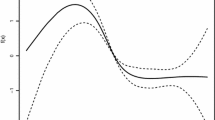Abstract
Tree-structured methods for exploratory data analysis have previously been extended to right-censored survival data. We further extend these methods to allow for truncation and time-dependent covariates. We apply the new methods to a data set on incubation times of acquired immunodeficiency syndrome (AIDS), using calendar time as a time-dependent covariate. Contrary to expectation, we find that rates of progression to AIDS appear to be faster after August 1989 than before.
Similar content being viewed by others
References
J. A. Anderson and A. Senthilselvan, “Smooth Estimates for the Hazard Function,”Journal of the Royal Statistical Society, Series B, vol. 42 pp. 322–327, 1980.
P. Bacchetti, “Estimating the Incubation Period of AIDS by Comparing Population Infection and Diagnosis Patterns,”Journal of the American Statistical Association, vol. 85 pp. 1002–1008, 1990.
L. Breiman, J. Friedman, R. Olshen, and C. Stone,Classification and Regression Trees, Wadsworth International Group: Belmont, CA, 1984.
R. Davis and J. Anderson, “Exponential Survival Trees,”Statistics in Medicine, vol. 8 pp. 947–962, 1989.
E. A. Gehan, “A Generalized Wilcoxon Test for Comparing Arbitrarily Singly-censored Samples,”Biometrika, vol. 52 pp. 203–223, 1965.
L. Gordon and R. Olshen, “Tree-Structured Survival Analysis,”Cancer Treatment Reports, vol. 69 pp. 1065–1069, 1985.
D. Harrington and T. Fleming, “A Class of Rank Test Procedures for Censored Survival Data,”Biometrika, vol. 69 pp. 553–566, 1982.
N. A. Hessol, B. A. Koblin, G. J. P. van Griensven, P. Bacchetti, J. Y. Liu, C. E. Stevens, R. A. Coutinho, S. P. Buchbinder, and M. H. Katz, “Progression of HIV-1 Infection Among Homosexual Men in Hepatitis B Vaccine Trial Cohorts in Amsterdam, New York City, and San Francisco 1978–1991,”American Journal of Epidemiology, vol. 139 pp. 1077–1087, 1994.
D. R. Hoover, A. Muñoz, Y. He, J. M. G. Taylor, L. Kingsley, J. S. Chmiel, and A. Saah, “The Effectiveness of Interventions on Incubation of AIDS as Measured by Secular Increases Within a Population,”Statistics in Medicine, vol. 13 pp. 2127–2139, 1994.
X. Huang, S. Chen, and S-J. Soong, “Piecewise Proportional Hazards Survival Trees With Time-dependent Covariates,”Computationally Intensive Statistical Methods: Proceedings of the 26th Symposium on the Interface, Research Triangle Park, North Carolina, June 15–18, 1994, 242–246.
E. L. Kaplan and P. Meier, “Nonparametric Estimation from Incomplete Observations,”Journal of the American Statistical Association, vol. 53 pp. 457–481, 1958.
T. L. Lai and Z. Ying, “Rank Regression Methods for Left-Truncated and Right-Censored Data,”Annals of Statistics, vol. 19 pp. 531–556, 1991.
B. Lausen and M. Schumacher, “Maximally Selected Rank Statistics,”Biometrics, vol. 48 pp. 73–85, 1992.
M. LeBlanc and J. Crowley, “Relative Risk Trees for Censored Survival Data,”Biometrics, vol. 48 pp. 411–425, 1992.
F. O'Sullivan, “Fast Computation of Fully Automated Log-Density and Log-Hazard Estimators,”SIAM Journal of Scientific and Statistical Computing, vol. 9 pp. 363–379, 1988.
R. Peto and J. Peto, “Asymptotically Efficient Rank-invariant Test Procedures,”Journal of the Royal Statistical Society, Series A, vol. 135 pp. 185–198, 1972.
R. L. Prentice, “Linear Rank Tests with Right-censored Data,”Biometrika, vol. 65 pp. 167–179, 1978.
M. R. Segal, “Regression Trees for Censored Data,”Biometrics, vol. 44 pp. 35–48, 1988.
M. R. Segal, P. Bacchetti, and N. P. Jewell (1994), “Variances for Maximum Penalized Likelihood Estimates Obtained via the EM Algorithm,”Journal of the Royal Statistical Society, Series B, vol. 56 pp. 345–352, 1994.
R. E. Tarone and J. Ware, “On Distribution-free Tests for Equality of Survival Distributions,”Biometrika, vol. 64 pp. 156–160, 1977.
J. M. G. Taylor, J-M. Kuo, and R. Detels, “Is the Incubation Period of AIDS Lengthening?”Journal of Acquired Immune Deficiency Syndromes, vol. 4 pp. 69–75, 1991.
W-Y. Tsai, N. P. Jewell, and M-C. Wang, “A Note on the Product-limit Estimator Under Right Censoring and Left Truncation,”Biometrika, vol. 74 pp. 883–886, 1987.
A. S. Whittemore and J. B. Keller, “Survival Estimates Using Splines,”Biometrics, vol. 42 pp. 495–506, 1986.
Z. Ying, “Linear Rank Statistics for Truncated Data,”Biometrika, vol. 77 pp. 909–914, 1990.
Author information
Authors and Affiliations
Rights and permissions
About this article
Cite this article
Bacchetti, P., Segal, M.R. Survival trees with time-dependent covariates: Application to estimating changes in the incubation period of AIDS. Lifetime Data Anal 1, 35–47 (1995). https://doi.org/10.1007/BF00985256
Received:
Accepted:
Issue Date:
DOI: https://doi.org/10.1007/BF00985256




